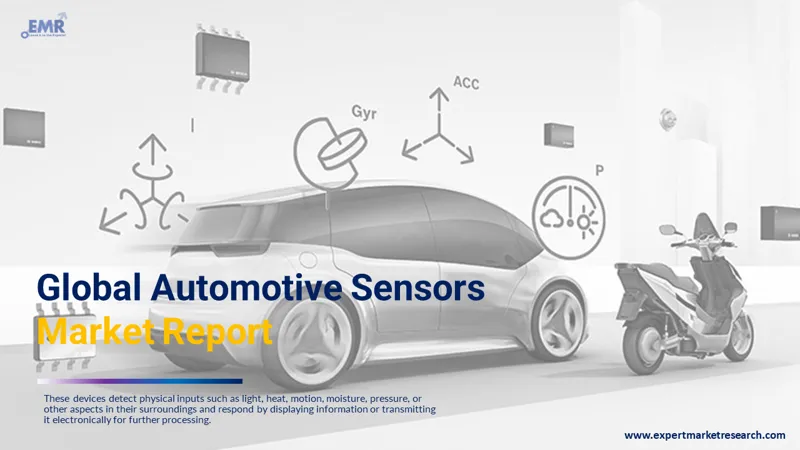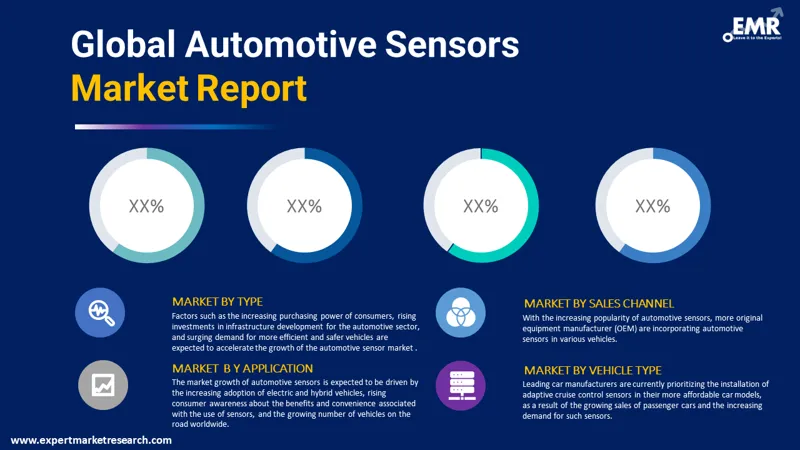
Consumer Insights
Uncover trends and behaviors shaping consumer choices today
Procurement Insights
Optimize your sourcing strategy with key market data
Industry Stats
Stay ahead with the latest trends and market analysis.
The global automotive sensors market attained a value of approximately USD 36.70 Billion in 2025. The market is further expected to grow at a CAGR of 9.50% in the forecast period of 2026-2035, reaching a value of around USD 90.95 Billion by 2035.
Base Year
Historical Period
Forecast Period
Compound Annual Growth Rate
9.5%
Value in USD Billion
2026-2035
*this image is indicative*
| Global Automotive Sensors Market Report Summary | Description | Value |
| Base Year | USD Billion | 2025 |
| Historical Period | USD Billion | 2019-2025 |
| Forecast Period | USD Billion | 2026-2035 |
| Market Size 2025 | USD Billion | 36.70 |
| Market Size 2035 | USD Billion | 90.95 |
| CAGR 2019-2025 | Percentage | XX% |
| CAGR 2026-2035 | Percentage | 9.50% |
| CAGR 2026-2035 - Market by Region | Asia Pacific | 10.3% |
| CAGR 2026-2035 - Market by Country | India | 10.5% |
| CAGR 2026-2035 - Market by Country | China | 10.1% |
| CAGR 2026-2035 - Market by Sales Channel | Aftermarket | 10.2% |
| CAGR 2026-2035 - Market by Vehicle Type | Passenger Car | 10.0% |
| Market Share by Country 2025 | Germany | 4.4% |
Automotive sensors refer to electronic devices that are designed to monitor specific aspects of vehicular performance and transmit information to the electronic control unit of the vehicle or to the driver. These devices can be used to check aspects such as pressure, temperature, position, speed, and gas. Automotive sensors are also capable of examining and determining range of values which would optimise vehicular performance.

Read more about this report - REQUEST FREE SAMPLE COPY IN PDF

Read more about this report - REQUEST FREE SAMPLE COPY IN PDF
The EMR’s report titled “Automotive Sensors Market Report and Forecast 2026-2035" offers a detailed analysis of the market based on the following segments:
Market Breakup by Sensor Type
Market Breakup by Application
Market Breakup by Sales Channel
Market Breakup by Vehicle Type
Market Breakup by Region
| CAGR 2026-2035 - Market by | Country |
| India | 10.5% |
| China | 10.1% |
| Brazil | 10.1% |
| Canada | 9.9% |
| Mexico | 9.8% |
| USA | XX% |
| UK | 9.6% |
| Germany | XX% |
| Italy | XX% |
| Japan | XX% |
| Australia | XX% |
| Saudi Arabia | XX% |
| France | 8.7% |
The powertrain segment, based on application, accounts for a healthy share of the automotive sensors market. Automotive powertrain sensors, such as manifold absolute pressure (MAP) sensor, barometric pressure sensor (BARO), and engine oil pressure sensor, are widely applied in powertrains. They are used to facilitate weather management, atmospheric pressure management, to optimise engine parameters, and to defined proper air and fuel quantities in order to improve the functioning of an automobile. Meanwhile, safety and control systems applications of automotive sensors are expected to witness steady growth in the forecast period, driven by the rising safety regulation standards amidst increasing cases of road accidents.
Based on vehicle type, the passenger car segment occupies a significant share in the automotive sensors market as automotive sensors are integral components in passenger vehicles to enhance the driving experience of customers. The increasing sale of luxury vehicles, SUVs, and sports cars, coupled with the increasing automobile maintenance expenditure of the population across emerging economies, is driving the segment’s growth. The rising preference towards safer, efficient, and eco-friendly cars is expected to bolster the incorporation of automotive sensors of sophisticated quality. Moreover, advancements in passenger vehicles being carried out by automotive manufacturers to gain a competitive edge are likely to aid the growth of this segment in the coming years.
The comprehensive EMR report provides an in-depth assessment of the market based on the Porter's five forces model along with giving a SWOT analysis. The report gives a detailed analysis of the key players in the global automotive sensors market, covering their competitive landscape and latest developments like mergers, acquisitions, investments and expansion plans.
Infineon Technologies AG is a leading semiconductor manufacturing company, the product portfolio of which includes battery management ICs, microcontroller, sensor, transceiver, software, and security and smart card solution, among others. The company was founded in 1999 and is headquartered in Neubiberg, Germany.
Robert Bosch GmbH is a renowned engineering company which develops smart mobility solutions in areas of hardware, software, and services. This company also offers services related to home, industry and trades, and market specific solutions. Founded in 1886, the company is based in Gerlingen, Germany.
NXP Semiconductors N.V. is a prominent semiconductor manufacturing company which provides smart, safe, and sustainable solutions related to automotive, industrial and IoT, mobile, and communication infrastructure markets. The company was established in 2006 and is headquartered in Eindhoven in the Netherlands.
*Please note that this is only a partial list; the complete list of key players is available in the full report. Additionally, the list of key players can be customized to better suit your needs.*
Other market players include Continental AG, and Littelfuse, Inc., among others.




*While we strive to always give you current and accurate information, the numbers depicted on the website are indicative and may differ from the actual numbers in the main report. At Expert Market Research, we aim to bring you the latest insights and trends in the market. Using our analyses and forecasts, stakeholders can understand the market dynamics, navigate challenges, and capitalize on opportunities to make data-driven strategic decisions.*
Get in touch with us for a customized solution tailored to your unique requirements and save upto 35%!
The market reached a value of USD 36.70 Billion in 2025.
The market is estimated to grow at a CAGR of 9.50% between 2026 and 2035.
The market is estimated to witness a healthy growth between the forecast period of 2026-2035, reaching a value of USD 90.95 Billion by 2035.
The major drivers of the market include increasing demand for passenger cars, thriving transportation sector, and growing focus on automotive safety.
The key trends in the market include technological advancements in automotive sensors, rapid electrification of motor vehicles, and increasing aftermarket sales of automotive sensors.
The different sensor types in the market for automotive sensors are temperature sensors, pressure sensors, level/position sensors, speed sensors, gas sensors, and magnetic sensors, among others.
The various applications of automotive sensors in the market are powertrain, chassis, vehicle body electronics, safety and control systems, telematics systems, and exhaust systems, among others.
The major market players, according to the report, are Infineon Technologies AG, Robert Bosch GmbH, NXP Semiconductors N.V., Continental AG, and Littelfuse, Inc., among others.
Explore our key highlights of the report and gain a concise overview of key findings, trends, and actionable insights that will empower your strategic decisions.
| REPORT FEATURES | DETAILS |
| Base Year | 2025 |
| Historical Period | 2019-2025 |
| Forecast Period | 2026-2035 |
| Scope of the Report |
Historical and Forecast Trends, Industry Drivers and Constraints, Historical and Forecast Market Analysis by Segment:
|
| Breakup by Sensor Type |
|
| Breakup by Application |
|
| Breakup by Sales Channel |
|
| Breakup by Vehicle Type |
|
| Breakup by Region |
|
| Market Dynamics |
|
| Competitive Landscape |
|
| Companies Covered |
|
| Report Price and Purchase Option | Explore our purchase options that are best suited to your resources and industry needs. |
| Delivery Format | Delivered as an attached PDF and Excel through email, with an option of receiving an editable PPT, according to the purchase option. |
Datasheet
One User
USD 2,499
USD 2,249
tax inclusive*
Single User License
One User
USD 3,999
USD 3,599
tax inclusive*
Five User License
Five User
USD 4,999
USD 4,249
tax inclusive*
Corporate License
Unlimited Users
USD 5,999
USD 5,099
tax inclusive*
*Please note that the prices mentioned below are starting prices for each bundle type. Kindly contact our team for further details.*
Flash Bundle
Small Business Bundle
Growth Bundle
Enterprise Bundle
*Please note that the prices mentioned below are starting prices for each bundle type. Kindly contact our team for further details.*
Flash Bundle
Number of Reports: 3
20%
tax inclusive*
Small Business Bundle
Number of Reports: 5
25%
tax inclusive*
Growth Bundle
Number of Reports: 8
30%
tax inclusive*
Enterprise Bundle
Number of Reports: 10
35%
tax inclusive*
How To Order

Select License Type
Choose the right license for your needs and access rights.

Click on ‘Buy Now’
Add the report to your cart with one click and proceed to register.

Select Mode of Payment
Choose a payment option for a secure checkout. You will be redirected accordingly.
Gain insights to stay ahead and seize opportunities.

Get insights & trends for a competitive edge.

Track prices with detailed trend reports.

Analyse trade data for supply chain insights.

Leverage cost reports for smart savings

Enhance supply chain with partnerships.

Connect For More Information
Our expert team of analysts will offer full support and resolve any queries regarding the report, before and after the purchase.
Our expert team of analysts will offer full support and resolve any queries regarding the report, before and after the purchase.
We employ meticulous research methods, blending advanced analytics and expert insights to deliver accurate, actionable industry intelligence, staying ahead of competitors.
Our skilled analysts offer unparalleled competitive advantage with detailed insights on current and emerging markets, ensuring your strategic edge.
We offer an in-depth yet simplified presentation of industry insights and analysis to meet your specific requirements effectively.
Share